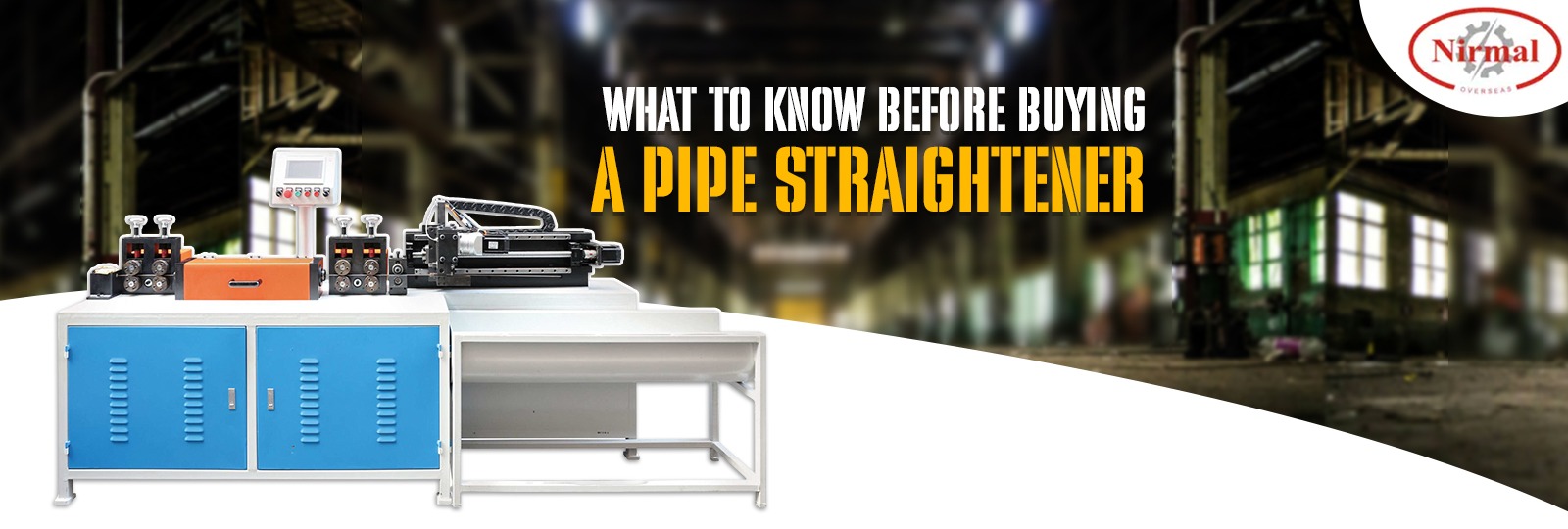
Making sure pipes are perfectly straight is necessary when manufacturing or processing them in the right industries. In the fields of construction, making trucks or tractors, working with oil and gas, and infrastructure development, anything from minor curving to warps in pipes can mean having to redo the project, as well as make the structures sturdier to resist damage. Therefore, purchasing an appropriate pipe straightener is very important for any production line.
Five significant points are discussed in this blog, which any buyer should think about before choosing a machine. Understanding all of this can guide you to a positive and successful outcome.
1. Material Compatibility & Pipe Size Range
One of the main things to check before buying a pipe straightening machine is whether it is suitable for your materials. Different machines are designed for different types of pipes. A few pieces of equipment are made for mill steel, while others are better used on pipes made of stainless steel, copper, aluminium, or plastic.
It is also important to check the range of sizes it can handle for both diameters and wall thickness. Picking a machine that is too big or too small for what you need can lead to its performance dropping or it becoming strained. Try to choose a machine with the right specifications so that it meets your needs and doesn’t face issues related to incompatible equipment.
2. Straightening Precision & Roll Configuration
The second main thing to look at is how well the machine controls its work and how its adjustment rolls are set up. Precision matters a lot, especially when it comes to jobs where getting the exact measurements is very important.
Roller configuration is very important for how well the steel can be straightened. Machines usually have 5, 7, or 9 rolls, and each setup is made for different levels of difficulty. More rollers usually give you more control and help straighten things up more evenly, especially if you have to work with tough or thick-walled pipes.
When checking how precise equipment is, you should also check the straightness limit that it can handle. For example, industries like aerospace and automotive usually need much stricter precision in their parts than you’d find in regular construction. Selecting a machine that can do the job exactly the way you need it will help make your product better and lower how much waste you have.
3. Build Quality & Machine Durability
The construction quality of the pipe straightening machine directly determines how long it will last and how well it runs over time. Industrial operations that need lots of constant running need a machine that can handle a lot of use and doesn’t break down often.
Check for strong frame pieces, usually made of cast iron or extra-strong steel, because these help curvaceous LP tanks last longer when they vibrate or handle bumps in the road. Additionally, think about how long the rollers will last and if there is a good system for putting oil or grease in the machine to keep everything running smoothly and cut down on the amount of maintenance needed.
Durable construction also means the performance of a car will mostly stay the same as years go by. A poorly built machine might start off working fine, but it won’t last as long and will need more repairs and breaks over time.
Read Also:- Manual vs. Automatic Pipe Straightening Machines: Which One is Better?
4. Automation, Controls & Ease of Use
Due to industrial automation, most current straightening machines are equipped with smart controls and features that make them easier and more efficient to use. For small-scale production, machines that require manual work may do the job, but larger enterprises should use semi- or fully automatic machines.
Choose appliances with interfaces that are easy for anyone to use, digital displays for control, set programs for operations, and features that help detect faults. They allow operators to learn the process faster and also make things safer and more productive for the whole team.
Automation cuts down on mistakes humans make, boosts how many items are produced, and provides a uniform output. It reduces the risk of workers getting tired and improves the quality of the final product.
5. After-Sales Support & Spare Parts Availability
The strength of one’s machines depends largely on the service they receive. Many people do not pay much attention to after-sales service during their purchase, yet it becomes vital when the product is in regular use or needs fixing.
Ensure you get help quickly from the company or supplier, regular service, and only use real spare parts for maintenance. Find repair centres that are convenient for you, or get details on how soon they can complete repairs and send the parts you need.
Receiving reliable support means you spend less time with your machines offline and use them for a longer period. It helps establish trust between you and the supplier, making it easier to make upgrades or buy new machines later on.
Warning Signs You Shouldn’t Ignore
Before finalizing your purchase, watch out for warning signs such as vague warranty terms, lack of transparency in technical specifications, or poor customer reviews. Always ask for product demonstrations, customer references, and service history to validate the machine’s performance in real-world conditions.
A machine that looks great on paper but lacks solid support and real-use validation can end up costing more in the long run.
Conclusion
When deciding on a pipe straightening machine, making sure it is compatible with your pipes, exact, properly designed, automatic when needed, and well supported afterwards can help your business.
Nirmal Overseas Private Limited understands why you want equipment that is reliable, easy to maintain, and suited to your output. All of our machines are designed for quality, thoroughness, and long life, and we make sure you are well looked after by our customer service. Should you have any questions or want to know more about our industrial solutions, please reach out to us.
